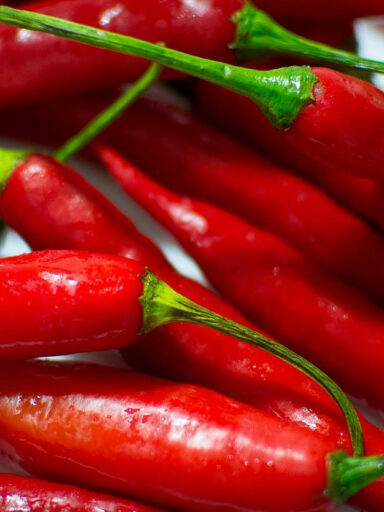The tomato is an edible savory fruit usually eaten as a vegetable. It is usually red in color when ripe and can be eaten raw or cooked. The name is derived from the Spanish “tomate”.
The fruit berries grow to weigh about 100 grams on average and are about the size of apples or onions when fully mature depending on the variety. It is therefore common to find varieties that vary in both size and color ranging from yellow to purple to green and white.
A common variety is the Cherry tomato which is round and marble-sized when mature and is common in Italian and Mediterranean cuisine.
The vine plant grows to about 1 to 3 meters in height. It is a perennial and annual plant depending on the climatic conditions in which it is grown. As a food, it originated in Mexico.
Ripe tomatoes should be bright and brilliant in color and have a rich fruity but savory flavor. The fresh fruit is firm and glossy in texture. It should not have mold, wrinkles, or blemishes. Tomatoes are available all year round at the marketplace.
You can buy tomatoes semi-ripe to store for longer periods before using them in food preparation. Ripe tomatoes are perishable and will keep for three to five days in a cool dry place or better yet, refrigerated. Unripe tomatoes can be left to ripen in cool storage or at room temperature. Like all vegetables, fresh tomatoes have the best nutritional value.
Preparing the Tomato for Culinary Use
The tomato should be thoroughly washed to remove pesticide residue and any dirt that may be on the berries. The stem should then be discarded and separated from the fruit. Cut into the desired shape be it slices, halves, quarters, cubes, or chopped up.
The entire fruit is edible even though some recipes call for discarding of the skin or the seeds. To remove the skin one can blanch the tomato in hot water for several seconds to separate the skin from the inner pulp.
Tomato is used to make soup, sauce dishes, and vegetable dishes. It is also used for meat, seafood, and poultry dishes. Tomato can be found in salad dishes, pizza, pie dishes, and other starters and entrée dishes.
They can be eaten raw in a sandwich, cold soup, relishes and salsa filling as well as in condiment preparations.
There is a debate as to whether a tomato is a fruit or vegetable. Botanically it is a fruit but because of its savory nature, in culinary contexts, it is consumed as a vegetable.
Nutritional Benefits
The tomato contains just 18 calories per 100 grams. It contains no cholesterol and has some amounts of dietary fiber making it ideal for weight loss programs. It is an excellent source of antioxidants, vitamins, and minerals.
They are rich in B-complex vitamins including folates, niacin, pyridoxine, and thiamin. vitamin A, vitamin C, and vitamin K are quite present in this vegetable.
Potassium, iron, and magnesium are abundant in this food as well. Other minerals present in the tomato are magnesium and phosphorus.



